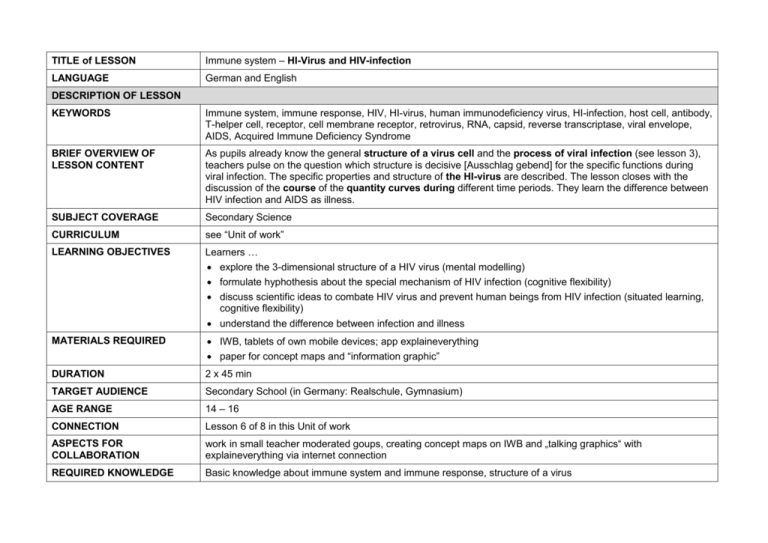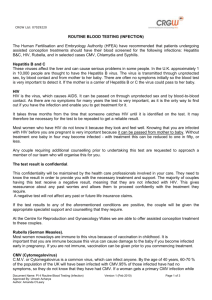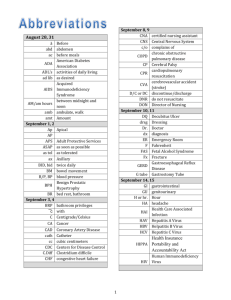TITLE of LESSON Immune system – HI-Virus and HIV
advertisement

TITLE of LESSON Immune system – HI-Virus and HIV-infection LANGUAGE German and English DESCRIPTION OF LESSON KEYWORDS Immune system, immune response, HIV, HI-virus, human immunodeficiency virus, HI-infection, host cell, antibody, T-helper cell, receptor, cell membrane receptor, retrovirus, RNA, capsid, reverse transcriptase, viral envelope, AIDS, Acquired Immune Deficiency Syndrome BRIEF OVERVIEW OF LESSON CONTENT As pupils already know the general structure of a virus cell and the process of viral infection (see lesson 3), teachers pulse on the question which structure is decisive [Ausschlag gebend] for the specific functions during viral infection. The specific properties and structure of the HI-virus are described. The lesson closes with the discussion of the course of the quantity curves during different time periods. They learn the difference between HIV infection and AIDS as illness. SUBJECT COVERAGE Secondary Science CURRICULUM see “Unit of work” LEARNING OBJECTIVES Learners … explore the 3-dimensional structure of a HIV virus (mental modelling) formulate hyphothesis about the special mechanism of HIV infection (cognitive flexibility) discuss scientific ideas to combate HIV virus and prevent human beings from HIV infection (situated learning, cognitive flexibility) understand the difference between infection and illness MATERIALS REQUIRED IWB, tablets of own mobile devices; app explaineverything paper for concept maps and “information graphic” DURATION 2 x 45 min TARGET AUDIENCE Secondary School (in Germany: Realschule, Gymnasium) AGE RANGE 14 – 16 CONNECTION Lesson 6 of 8 in this Unit of work ASPECTS FOR COLLABORATION work in small teacher moderated goups, creating concept maps on IWB and „talking graphics“ with explaineverything via internet connection REQUIRED KNOWLEDGE Basic knowledge about immune system and immune response, structure of a virus EDUCATIONAL DESCRIPTION OF LEARNING ACTIVITY / ACTIVITIES SUGGESTIONS FOR USE IN THE CLASSROOM 1 2 ACTIVITY DESCRIPTION METHODOLOGY KEY QUESTIONS FOR SCAFFOLDING Structure of HI-virus The interactive resource “Structure of an HI-virus” explores the characteristical components of this special virus. Alternative to a static 2D-model a turnable and zoomable 3D-model should be used. Teachers can use this micromodule to moderate pupils work while they investigate the HIV virus by their own on a tablet or desktop computer. Teacher focuses dialogue on the understanding, that specific virus structure (or components) have specific functions. Know the specific structures of a HI-virus and explain their specific functions. ACTIVITY DESCRIPTION METHODOLOGY KEY QUESTIONS FOR SCAFFOLDING “Reproduction of an HI-virus” Cooperative concept mapping to describe the complex process of HI-virus infection and reproduction. Describe the typical phases of virus infection and virus reproduction (repetition, compare lesson 3). The interactive resource “Reproduction of an HI-virus” shows an step by step trickfilm of the process of HIV infection. Special focus here is the contact junction between virus and host cell using a specific cell membrane receptor. Pupils remember the general processes of viral infection (see lesson 3) and transfer knowledge to specific conditions of HIV infection. Teachers can inform pupils, that HIV virus attacks T-helper cells in special to multiply itself. Pupils may formulate hypothesis on the consequences to immune response in this case. LEARNING OBJECT/S The interactive resource “Structure of HI-virus” provides a deep insight into structure and function of molecular components of a virus The strategy of HI-virus has a fatal impact of human immunity because it uses T-helper cells as host cells. Explain. LEARNING OBJECT/S The interactive resource “Reproduction of an HI-virus” shows an step by step trickfilm of the process of HIV infection 3 ACTIVITY DESCRIPTION METHODOLOGY KEY QUESTIONS FOR SCAFFOLDING “HIV infection – from infection to illness” Creating a „talking graphic“ on IWB or tablets – if possible via network connection (i.e. with app explaineverything). This graphic points out small informations texts posted on the curves to the three phases of HIV-infection. Pupils formulate hypothetic strategies to defend the virus in the different stages of infection, incubation an illness. Talk, discussion, documentation and presentation allows international cooperative / collaborative learning situations. An infection by HI-virus often remains unnoticed by the patient. Understand the difference between infection, incubation and illness (AIDS). The interactive resource “HIV infection – from infection to illness” shows the course taken by infectious deseases in 3 phases. It indicates the relative quantities in blood of HIV virus, antibodies and T-helper cells. Pupils can estimate the course of the quantity curves during different time periods. They learn the difference between HIV infection and AIDS as illness. 4 LEARNING OBJECT/S The interactive resource “HIV infection” indicates the relative quantities in blood of HI-virus, antibodies and T-helper cells. QUESTIONS FOR WHOLE CLASS DISCUSSION FOLLOWING LEARNING ACTIVITIES: > See “Key Questioning for scaffolding” ASSESSMENT METHODS DIFFERENTIATION Teacher moderates group phases, teacher observation Results on tablets, smartphones, IWB Results with concept maps and “talking graphic” Mixed ability groups for active working Buddy system to aid less able children Differentiated questioning to support and challenge less able and exceptionally able children Differentiated documentation records on IWB (concept map) or “talking graphic” (print or app) CREATOR Steffen Schaal, Toni Cramer RIGHTS Creative Commons 3.0 (or use only, if resource from Klett Verlag) ANNOTATION USER ANNOTATION DESCRIPTION







